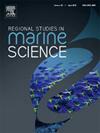A case study of biogeophysical and optical water quality indicators-of-change along marine-terminating glaciers including fjördal zones west of Iceland and Greenland
IF 2.1
4区 环境科学与生态学
Q3 ECOLOGY
引用次数: 0
Abstract
The discharge of particulate and dissolved material into high latitude estuarine systems has been increasing due to melting of ice sheets, sea ice and glaciers. High quality in-situ datasets of biogeophysical and optical water quality variables (WQVs, indicators-of-change) are therefore essential to improve scientific evidence-based knowledge especially of the dynamic changes along marine-terminating glaciers and related remote high latitude waters. Here, a quantification of WQVs is described based on the surveyed surface waters west of Greenland and Iceland between July and August 2012. Measured WQVs included chlorophyll-a, coloured dissolved organic matter (CDOM), Forel-Ule colour Index, hyperspectral radiometric quantities, salinity, Secchi disk depth, suspended particulate material, temperature and turbidity covering a wide geo-spatial gradient. The study also investigated the geo-spatial distribution and trends exhibited by the gathered WQVs. Statistical tests were applied to investigate associations among the WQVs and to establish predictive regression models. The spectral slope of CDOM was observed to share an indirect relationship with the derived absorption coefficient. The algorithms established were evaluated and showcased as alternative solutions to support filling data gaps in WQVs measurements by leveraging ocean colour remote sensing as well as classic water clarity tools. The presented research also emphasises the importance of contributing towards high quality open-access datasets that can be assimilated into relevant ocean models and observing repositories (e.g., Greenland Ice Sheet - Ocean Observing System). Furthermore, gathering more WQVs from remote high latitude waters using in-situ and remote sensing approaches has the potential to improve scientific knowledge about environmental changes that might be linked to the United Nations coined Triple Planetary Crisis. Additionally, large diverse high quality datasets of WQVs will play a vital role in accurate predictive regression models that could be supported by machine learning for enhanced now- and forecasting of environmental changes.
生物地球物理和光学水质变化指标沿海洋终止冰川的案例研究,包括冰岛和格陵兰岛西部fjördal地区
由于冰盖、海冰和冰川的融化,向高纬度河口系统排放的微粒和溶解物质一直在增加。因此,高质量的生物地球物理和光学水质变量(wqv,变化指标)的原位数据集对于提高基于证据的科学知识至关重要,特别是关于海洋终点冰川和相关偏远高纬度水域的动态变化。本文基于2012年7月至8月期间格陵兰岛和冰岛西部地表水的调查,对WQVs进行了量化描述。测量的wqv包括叶绿素-a、彩色溶解有机质(CDOM)、Forel-Ule颜色指数、高光谱辐射量、盐度、塞奇盘深度、悬浮颗粒物、温度和浊度,覆盖了广泛的地理空间梯度。研究还分析了收集到的wqv的地理空间分布和趋势。采用统计学检验探讨wqv之间的相关性,并建立预测回归模型。CDOM的光谱斜率与导出的吸收系数有间接关系。对所建立的算法进行了评估和展示,作为利用海洋颜色遥感和经典水清晰度工具来填补wqv测量数据空白的替代解决方案。所提出的研究还强调了促进高质量开放获取数据集的重要性,这些数据集可以被吸收到相关的海洋模型和观测库中(例如,格陵兰冰盖-海洋观测系统)。此外,利用原位和遥感方法从遥远的高纬度水域收集更多的wqv,有可能改善有关环境变化的科学知识,这些变化可能与联合国提出的“三重地球危机”有关。此外,大量不同的高质量wqv数据集将在准确的预测回归模型中发挥至关重要的作用,这些模型可以通过机器学习来支持,以增强对环境变化的预测。
本文章由计算机程序翻译,如有差异,请以英文原文为准。
求助全文
约1分钟内获得全文
求助全文
来源期刊

Regional Studies in Marine Science
Agricultural and Biological Sciences-Ecology, Evolution, Behavior and Systematics
CiteScore
3.90
自引率
4.80%
发文量
336
审稿时长
69 days
期刊介绍:
REGIONAL STUDIES IN MARINE SCIENCE will publish scientifically sound papers on regional aspects of maritime and marine resources in estuaries, coastal zones, continental shelf, the seas and oceans.
 求助内容:
求助内容: 应助结果提醒方式:
应助结果提醒方式:


